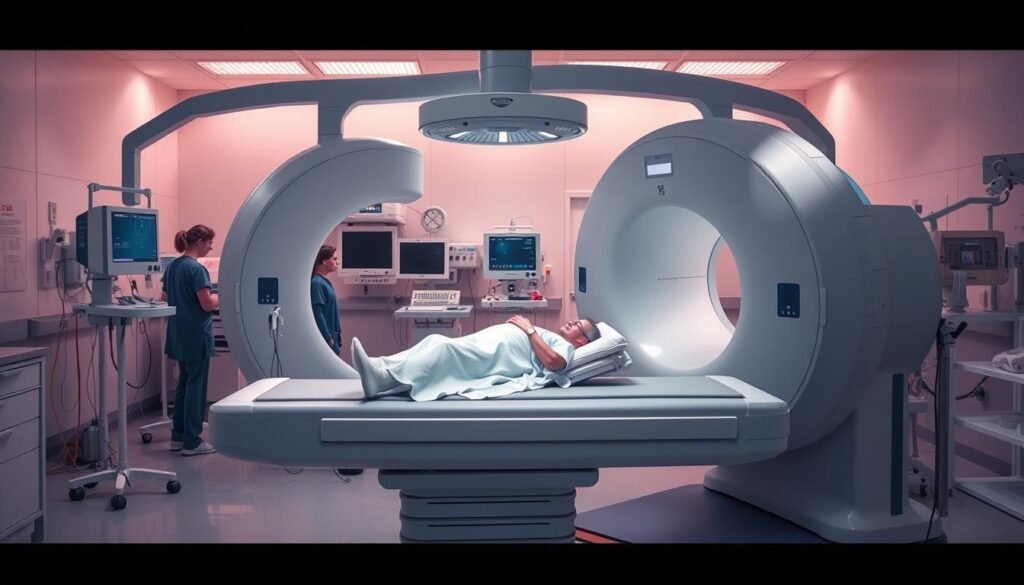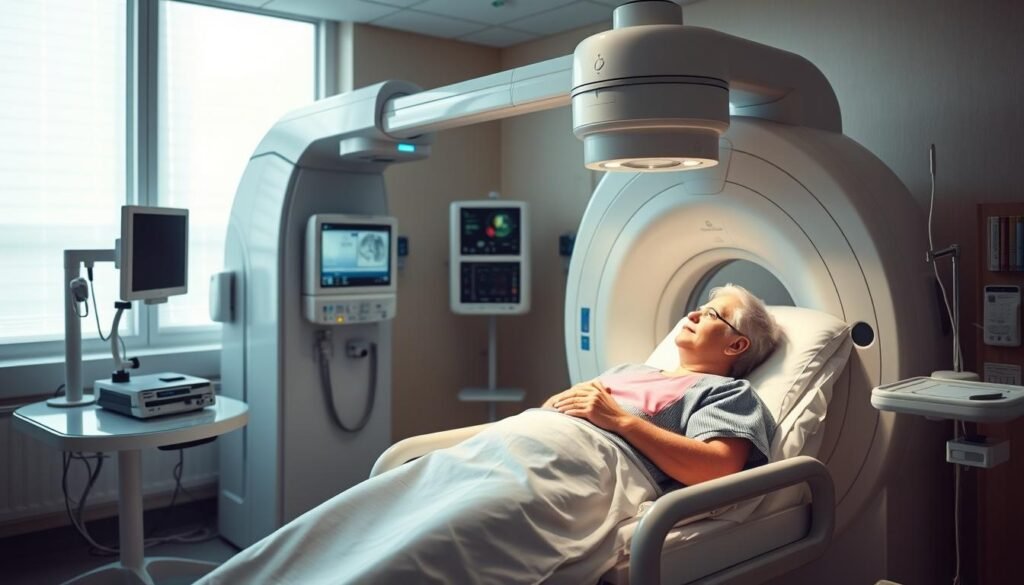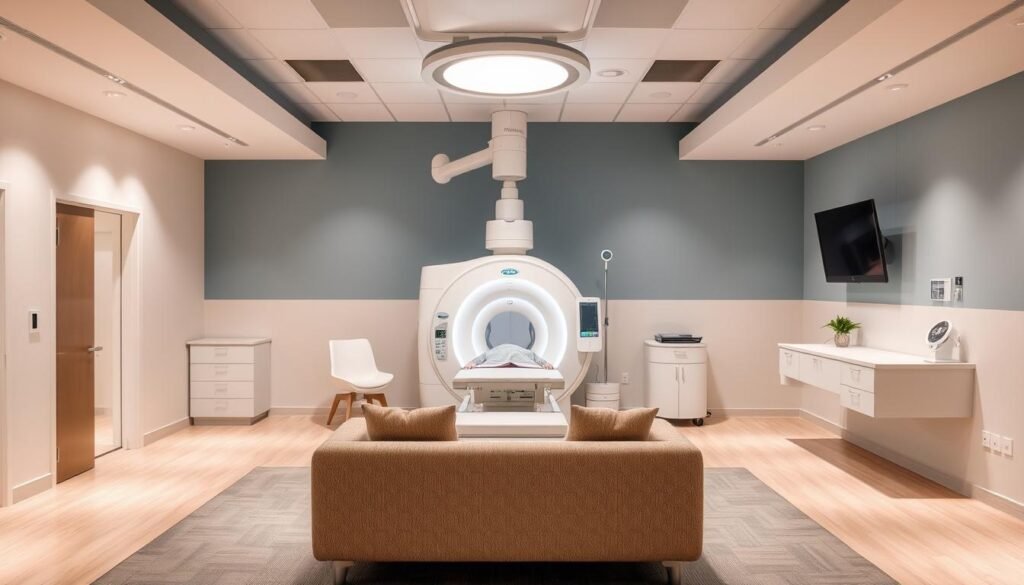Did you know SBRT patients have a 5-year disease control rate of 96%? That beats the 95% rate with traditional radiation. As cancer treatments improve, it’s vital to know how SBRT and conventional radiation differ. We’ll look into their effectiveness, survival rates, and what patients go through.
SBRT and traditional radiation play big roles in fighting cancer. Yet, they are different in how they treat patients and the results they achieve. Traditional radiation takes longer, but SBRT requires fewer hospital visits, which is easier for most people. Studies like the PACE B are finding new ways to fight cancer. They give us hope for better results with different cancers. For more on lung cancer, check out this useful link.
Key Takeaways
- SBRT boasts a higher 5-year disease control rate compared to traditional radiation therapy.
- Patients typically experience shorter treatment duration with SBRT.
- Emerging studies indicate comparable long-term survival rates for SBRT and conventional therapies.
- Understanding the side effects of each treatment is crucial for patient safety.
- Both treatment modalities are vital in the fight against cancer, depending on the specific case.
Understanding Radiation Therapy
Radiation therapy is key in fighting cancer. It uses high doses of radiation to kill cancer cells. While doing this, it tries to save the healthy tissue around the cancer. Over time, the way we use radiation therapy has gotten better, offering different ways to treat patients.
What is Radiation Therapy?
Radiation therapy is a way to treat cancer by using radiation to kill or harm cancer cells. It comes in various forms and techniques aimed at specific areas. This treatment works by damaging the cancer cells’ DNA, stopping their growth and spread. Each patient gets a tailored treatment plan based on their unique situation and health.
Types of Radiation Therapy
Radiation therapy comes in two main types:
- External Beam Radiation Therapy: In this method, radiation is aimed at the tumor from outside the body. It uses linear accelerators for precise targeting. This way, healthy tissues stay as safe as possible.
- Internal Radiation Therapy (Brachytherapy): This technique involves putting radioactive material right next to or in the tumor. It allows for high doses of radiation right where it’s needed, with less effect on healthy tissues.
Traditional radiation therapy has been a cornerstone in treating cancer for a long time. As new techniques are developed, they bring hope for better results in cancer care. These advances help doctors improve how they treat cancer, aiming for better success rates.
What is Stereotactic Body Radiation Therapy (SBRT)?
Stereotactic Body Radiation Therapy (SBRT) is a groundbreaking way to treat cancer with radiation. It uses high doses in fewer visits, unlike traditional treatments. This method is precise thanks to advanced imaging. It targets tumors accurately while protecting healthy tissue.
Definition and Overview of SBRT
SBRT stands out in treating many cancers, like those in the lung, liver, and spine. It sends radiation from many angles, focusing on the tumor. This approach limits damage to nearby organs. SBRT is crucial for treating small-to-medium tumors, whether they are cancerous or not.
Mechanism of Action
SBRT’s success comes from using detailed imaging and careful planning. Techniques like IGRT help target the tumor with precision. A team of specialists works together to ensure the best results. Tools like the Gamma Knife or LINAC machines are often used, making SBRT effective and reliable.
SBRT shortens treatment to about 1-2 weeks. Its results are often better than traditional methods. This makes it an attractive option for those needing efficient cancer care without a long break from daily life.
What is Traditional Radiation Therapy?
Traditional radiation therapy, or CRT, is key in fighting cancer. It usually involves daily treatments for many weeks. A linear accelerator targets the cancer cells carefully, protecting healthy tissues. CRT uses methods like 3D conformal radiation therapy and intensity-modulated radiation therapy (IMRT).
Definition and Overview of Conventional Radiation Therapy
CRT fights cancer with fractionated doses over several sessions. Patients might need 30 to 45 sessions in total. Each one delivers radiation to fight cancer slowly, allowing normal cells to repair.
Mechanism of Action
CRT works by harming the DNA in cancer cells, which divide quickly. The damaged DNA stops these cells from multiplying, causing their death. Advanced imaging helps target cancer accurately with a linear accelerator, saving healthy tissues.

SBRT vs. Traditional Radiation: A Comparison
In the field of cancer treatment, it’s vital to compare different radiation therapies. This helps ensure patients get the best care. We will look at SBRT and traditional radiation to see how they stack up.
Effectiveness in Cancer Treatment
SBRT has been effective for certain cancers, especially smaller tumors. Research shows success rates for SBRT are between 80 to 90 percent. This is much higher than the 30 to 40 percent with traditional treatments. SBRT shines for tumors up to 6–7 cm in size. It’s a good option when surgery isn’t possible.
Patient Survival Rates and Outcomes
Survival rates offer a detailed look. Studies show SBRT and traditional radiation have similar survival after six years. But, it’s important to understand the details behind these numbers. There’s little difference in death risk between the two, even for high-risk patients. While direct evidence of SBRT’s benefits with ADT for higher risk cancer is limited, studies suggest it’s as effective as traditional methods. This supports SBRT’s place in cancer treatment today.
| Treatment Method | Success Rates | Typical Treatment Duration | Overall Survival Rate (6-Year) |
|---|---|---|---|
| SBRT | 80-90% | 3-5 treatments over 1-2 weeks | Similar |
| Conventional Radiation | 30-40% | Several weeks of continuous treatment | Similar |
Choosing the right treatment is crucial for patients. Knowing the differences between SBRT and traditional radiation is key. As technology improves, so will our methods for fighting cancer.
Applications of SBRT in Cancer Treatment
Stereotactic body radiation therapy (SBRT) is becoming popular for treating many cancers. It works well for lung and prostate cancer. Its precision lets doctors use high radiation doses directly on tumors. This approach protects healthy tissue around them. This improves the treatment’s effectiveness, making it a key part of modern radiation therapy.
SBRT for Lung Cancer Treatment
SBRT is a strong option for those with lung cancer, especially if surgery isn’t possible. It’s a non-invasive method that reduces treatment time. Clinical studies have shown its benefits, including a shorter treatment period. Patients get between 20 to 60 Gy of radiation in 1 to 5 sessions. This means less time in treatment, which can lead to better results.
SBRT for Prostate Cancer Treatment
In treating prostate cancer, SBRT stands out as a viable choice over traditional methods. Research shows it’s just as effective, but with lower toxicity. Patients also appreciate fewer trips to the clinic. This makes the treatment experience better overall. SBRT helps patients recover faster and stick to their treatment plans.
SBRT is changing how doctors treat cancer due to its strong results in many tumor types. For more details on SBRT’s success and guidelines, check out this study.
Applications of Traditional Radiation in Cancer Treatment
Traditional radiation therapy is key in treating lung and prostate cancers. It’s really useful for patients with operable tumors. Doctors have fine-tuned radiation methods over time. They aim to improve patients’ health and life quality.
Traditional Radiation for Lung Cancer
External beam radiation therapy is a mainstay for lung cancer. It has been for many years. About 60% of patients see their symptoms get better with this therapy. The treatment spans weeks, using steady radiation doses. It aims to reduce tumors and help with symptoms.
Even though it works well, some patients face side effects. These side effects can lower their life quality. Because of this, they might need more treatments.
Traditional Radiation for Prostate Cancer
Prostate cancer treatments often use traditional radiation methods. These methods spread doses out to fight cancer effectively. While SBRT, a new technique, is becoming popular, many still choose traditional radiation. It follows proven protocols.
For numerous patients, traditional radiation is a trusted method to combat prostate cancer. It offers them a solid option during their health journey.

| Aspect | Lung Cancer Treatment | Prostate Cancer Treatment |
|---|---|---|
| Standard Treatment | External Beam Radiation Therapy | Conventional Radiation Therapy |
| Pain Relief Rate | Around 60% | Varies with individual treatment |
| Side Effects | Can impact quality of life | Less severe compared to lung cancer |
| Treatment Duration | Multiple weeks for fractions | Set fractions based on protocol |
Radiation Side Effects
Both stereotactic body radiation therapy (SBRT) and traditional radiation therapy have side effects. It’s important to know about radiation side effects before choosing a treatment. This knowledge helps pick the best option for individual needs.
Common Side Effects of SBRT
SBRT can cause several side effects, such as:
- Fatigue
- Localized skin irritation
- Minor radiation pneumonitis
These SBRT side effects tend to be milder. Thus, SBRT is a good choice for many. The shorter treatment time may also mean fewer side effects.
Common Side Effects of Traditional Radiation
In comparison, conventional radiation therapy can cause more problems. Some typical side effects are:
- Esophagitis
- Long-term respiratory decline
- Skin burns or irritation
Conventional radiation side effects can make recovery harder. However, SBRT usually has lower risks of major side effects. This fact makes it a better choice in some cases.
| Type of Radiation | Common Side Effects | Severity |
|---|---|---|
| SBRT | Fatigue, Skin Irritation, Minor Radiation Pneumonitis | Generally Mild |
| Conventional Radiation | Fatigue, Esophagitis, Long-term Respiratory Decline | Moderate to Severe |
Both options carry risks. More studies are needed to better understand radiation side effects. This will help us know more about their impact on long-term health and life quality.
Comparative Efficacy of SBRT and Traditional Radiation
Recent studies compare Stereotactic Body Radiation Therapy (SBRT) with traditional radiation. This research is crucial for understanding how well treatments work and patient outcomes in cancer care.
Statistics from Recent Studies
Studies show SBRT improves outcomes for certain cancers. About 54% of patients see significant pain reduction after six months of SBRT. And in some cases, up to 90% of patients report pain improvements.
In contrast, traditional radiation has much lower success in reducing pain, between 0 to 23%. Only about 60% of patients find relief from pain with external beam radiotherapy. This shows the different success rates between the two treatments.
Long-Term Follow-Up Results
Looking at long-term outcomes, SBRT’s benefits stand out. A study of 41,355 men with prostate cancer showed no big difference in six-year survival rates between SBRT and traditional therapy. The risk of dying was similar in both treatment groups.
SBRT is appealing because it takes fewer sessions, 3 to 5 over one to two weeks. Traditional therapy needs daily sessions for several weeks. Studies support SBRT is a good choice, especially for patients with a limited spread of disease.
Patient Experience and Convenience
Choosing the right treatment, like SBRT or traditional radiation, is crucial for patients. What makes a big difference is how long the treatment takes and how many sessions you need. This really impacts how patients feel about their care.
Treatment Duration and Sessions
SBRT stands out because it’s much quicker. Patients usually finish their treatment in just a handful of sessions. This means they don’t have to change their daily life too much. On the other hand, traditional radiation therapy takes much longer, often requiring daily visits for several weeks. Below is a comparison:
| Treatment Type | Treatment Sessions | Duration |
|---|---|---|
| SBRT | 3-5 sessions | 1-2 weeks |
| Traditional Radiation | 20-30 sessions | 4-6 weeks |
Patient Comfort and Convenience
SBRT not only cuts down on the number of sessions but also makes each visit easier. It uses advanced tech to hit tumors more accurately, leading to fewer side effects. Patients tend to prefer SBRT. They like having fewer doctor visits and less interference with their day-to-day life.

Future Directions in Radiation Oncology
The field of radiation oncology is changing fast, thanks to new methods and tech. The future looks bright, as we work on making treatments better. This includes using SBRT technologies more in fighting cancer. Doctors and researchers are always finding new ways to treat patients better. They focus on what each person needs.
Emerging Technologies in SBRT
SBRT technology is getting better, making treatments more precise. The Varian® On-Board Imager® (OBI) system is one example. It provides clear images with less radiation. This helps doctors position patients perfectly for targeted treatment.
With this tech, patients can get high doses of radiation quickly, in just a few visits. SBRT shows over 90% success in hitting tumors accurately, while keeping healthy tissue safe. This ongoing progress means radiation oncology has a promising future.
Potential Advancements for Traditional Radiation
Improvements in traditional radiation focus on patient safety and comfort. For example, SpaceOAR hydrogel guards the body during prostate cancer treatments. It lessens radiation damage to the rectum. Studies from Europe and the U.S. show it helps reduce pain and later health issues.
As new methods get better, they blend with old ones. This could mean even better results and less harm to patients.
Working together is key to advancing radiation oncology. New imaging means and treatment options are improving SBRT and traditional methods. This teamwork will keep pushing cancer treatment forward. It aims to increase the quality of patient care and help people live longer.
To learn more about recent progress in radiation therapy, see this article on SBRT and its clinical use.
Expert Opinions on SBRT and Traditional Radiation
Experts have a lot to say about the benefits and challenges of SBRT vs. traditional radiation. They’re really into SBRT for some cancers, noting it cuts down on treatment time. It also leads to better outcomes for patients. The key, they say, is tailoring the treatment to each person.
Insights from Radiation Oncologists
Radiation oncologists are excited about SBRT. It’s super precise, targeting only the tumor and saving healthy tissue. This means patients have fewer side effects. Many doctors have seen patients live longer, especially those with early-stage lung cancer. Research backs this up, showing SBRT can offer a better chance of survival than old-school radiation.
Patient Testimonials and Experiences
Patients often agree with what the doctors say. Those who’ve had SBRT talk about having less side effects and a better life quality. They’re happy with the shorter treatment times. It makes life easier, reducing how much they have to travel. They feel their treatment is really made for them, valuing the personal touch.
| Aspect | SBRT | Traditional Radiation Therapy |
|---|---|---|
| Treatment Duration | Fewer sessions (e.g., 5 for prostate cancer) | More sessions (e.g., 20 for prostate cancer) |
| Survival Rates | Improved outcomes (e.g., 1-year OS rate: 86.23%) | Lower survival rates (e.g., 1-year OS rate: 77.80%) |
| Quality of Life | Less overall adverse effects reported | More potential side effects |
| Patient Satisfaction | High satisfaction with care and lower travel burden | Varied satisfaction levels |
Conclusion
The study of SBRT versus traditional radiation shows clear benefits for certain lung cancer patients. Specifically, post-surgery patients with isolated lung tumors see better outcomes. SBRT leads with a 3-year survival rate of 81%, while traditional treatments offer 40%.
Additionally, SBRT has a higher rate of controlling the cancer locally, with 83% compared to 35% for traditional methods. This makes SBRT a more appealing choice in today’s cancer care. It’s especially true as we seek more effective treatments.
SBRT stands out in radiation oncology by needing fewer sessions and being more precise. Its side effects, like radiation pneumonitis, are similar to those of traditional treatments. Yet, the advantages it brings may outweigh these risks for some patients. This insight highlights the need for making informed treatment decisions.
With ongoing research and broader use of SBRT, healthcare providers must stay updated. This ensures that care revolves around the patient, helping them make smart choices about their treatment. For more in-depth information, check the research article on SBRT and CFRT.